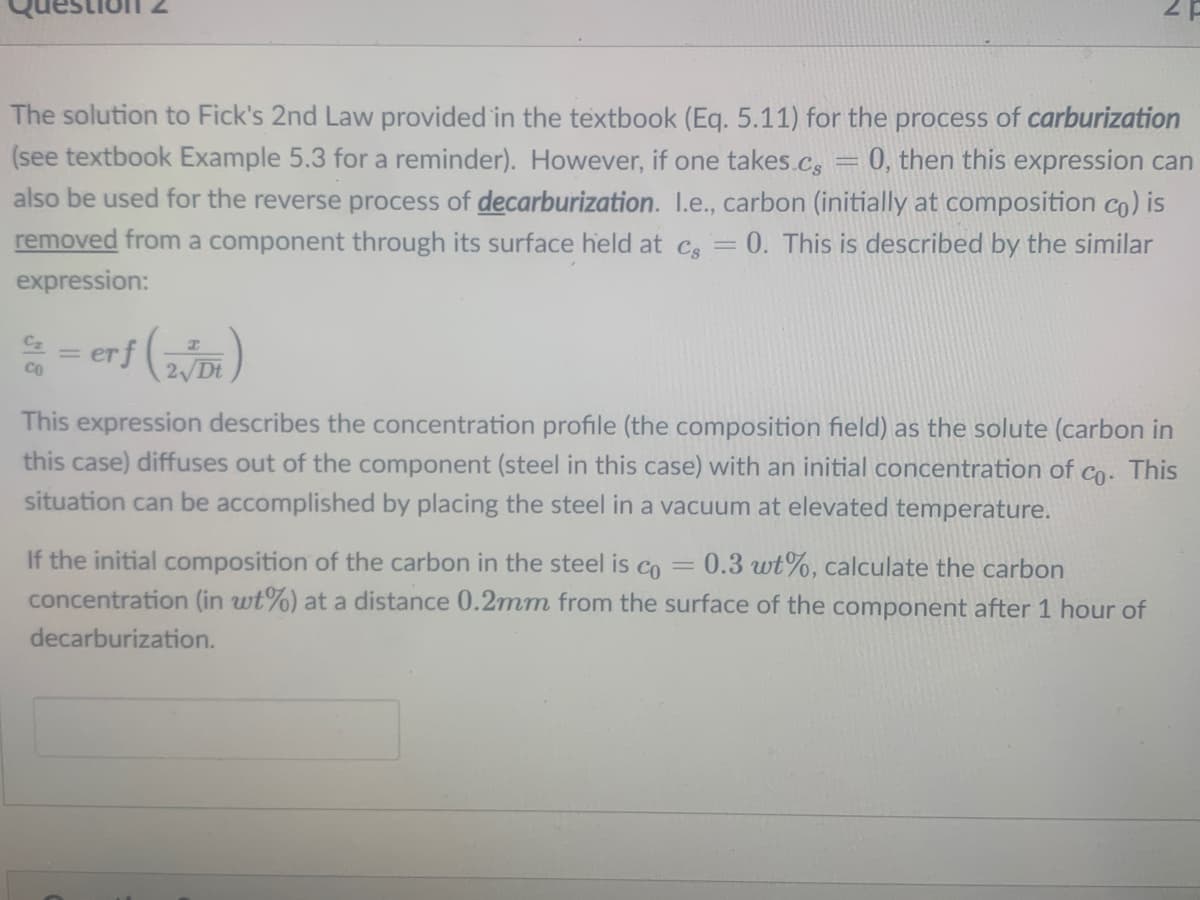The solution to Fick's 2nd Law provided in the textbook (Eq. 5.11) for the process of carburization (see textbook Example 5.3 for a reminder). However, if one takes.cg 0, then this expression can also be used for the reverse process of decarburization. I.e., carbon (initially at composition co) is removed from a component through its surface held at c, = 0. This is described by the similar expression: = & = erf (2/₁) This expression describes the concentration profile (the composition field) as the solute (carbon in this case) diffuses out of the component (steel in this case) with an initial concentration of Co. This situation can be accomplished by placing the steel in a vacuum at elevated temperature. = If the initial composition of the carbon in the steel is co 0.3 wt%, calculate the carbon concentration (in wt%) at a distance 0.2mm from the surface of the component after 1 hour of decarburization.
The solution to Fick's 2nd Law provided in the textbook (Eq. 5.11) for the process of carburization (see textbook Example 5.3 for a reminder). However, if one takes.cg 0, then this expression can also be used for the reverse process of decarburization. I.e., carbon (initially at composition co) is removed from a component through its surface held at c, = 0. This is described by the similar expression: = & = erf (2/₁) This expression describes the concentration profile (the composition field) as the solute (carbon in this case) diffuses out of the component (steel in this case) with an initial concentration of Co. This situation can be accomplished by placing the steel in a vacuum at elevated temperature. = If the initial composition of the carbon in the steel is co 0.3 wt%, calculate the carbon concentration (in wt%) at a distance 0.2mm from the surface of the component after 1 hour of decarburization.
Introduction to Chemical Engineering Thermodynamics
8th Edition
ISBN:9781259696527
Author:J.M. Smith Termodinamica en ingenieria quimica, Hendrick C Van Ness, Michael Abbott, Mark Swihart
Publisher:J.M. Smith Termodinamica en ingenieria quimica, Hendrick C Van Ness, Michael Abbott, Mark Swihart
Chapter1: Introduction
Section: Chapter Questions
Problem 1.1P
Related questions
Question

Transcribed Image Text:The solution to Fick's 2nd Law provided in the textbook (Eq. 5.11) for the process of carburization
(see textbook Example 5.3 for a reminder). However, if one takes.Cs
0, then this expression can
also be used for the reverse process of decarburization. I.e., carbon (initially at composition co) is
removed from a component through its surface held at c, = 0. This is described by the similar
%3D
expression:
erf (
2 Dt
This expression describes the concentration profile (the composition field) as the solute (carbon in
this case) diffuses out of
component (steel in this case) with an initial concentration of co. This
situation can be accomplished by placing the steel in a vacuum at elevated temperature.
If the initial composition of the carbon in the steel is co =
0.3 wt%, calculate the carbon
concentration (in wt%) at a distance 0.2mm from the surface of the component after 1 hour of
decarburization.
Expert Solution
This question has been solved!
Explore an expertly crafted, step-by-step solution for a thorough understanding of key concepts.
This is a popular solution!
Trending now
This is a popular solution!
Step by step
Solved in 2 steps

Recommended textbooks for you

Introduction to Chemical Engineering Thermodynami…
Chemical Engineering
ISBN:
9781259696527
Author:
J.M. Smith Termodinamica en ingenieria quimica, Hendrick C Van Ness, Michael Abbott, Mark Swihart
Publisher:
McGraw-Hill Education

Elementary Principles of Chemical Processes, Bind…
Chemical Engineering
ISBN:
9781118431221
Author:
Richard M. Felder, Ronald W. Rousseau, Lisa G. Bullard
Publisher:
WILEY

Elements of Chemical Reaction Engineering (5th Ed…
Chemical Engineering
ISBN:
9780133887518
Author:
H. Scott Fogler
Publisher:
Prentice Hall

Introduction to Chemical Engineering Thermodynami…
Chemical Engineering
ISBN:
9781259696527
Author:
J.M. Smith Termodinamica en ingenieria quimica, Hendrick C Van Ness, Michael Abbott, Mark Swihart
Publisher:
McGraw-Hill Education

Elementary Principles of Chemical Processes, Bind…
Chemical Engineering
ISBN:
9781118431221
Author:
Richard M. Felder, Ronald W. Rousseau, Lisa G. Bullard
Publisher:
WILEY

Elements of Chemical Reaction Engineering (5th Ed…
Chemical Engineering
ISBN:
9780133887518
Author:
H. Scott Fogler
Publisher:
Prentice Hall


Industrial Plastics: Theory and Applications
Chemical Engineering
ISBN:
9781285061238
Author:
Lokensgard, Erik
Publisher:
Delmar Cengage Learning

Unit Operations of Chemical Engineering
Chemical Engineering
ISBN:
9780072848236
Author:
Warren McCabe, Julian C. Smith, Peter Harriott
Publisher:
McGraw-Hill Companies, The